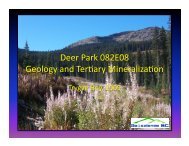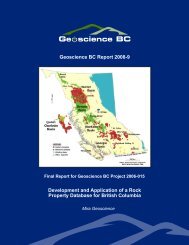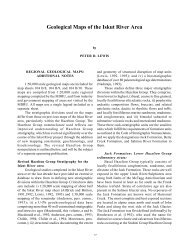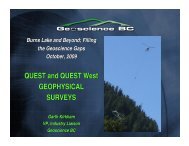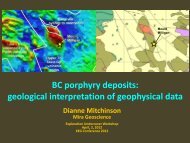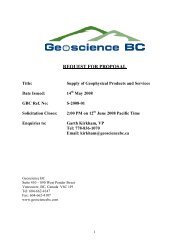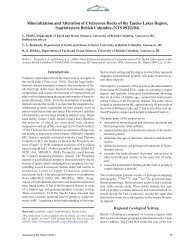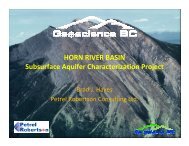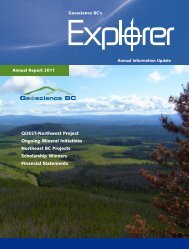Report - Geoscience BC
Report - Geoscience BC
Report - Geoscience BC
Create successful ePaper yourself
Turn your PDF publications into a flip-book with our unique Google optimized e-Paper software.
made on all samples after being vacuum saturated with agitated, deionized, distilled water for at<br />
least 15 hours.<br />
Two fundamental body wave types travel through material: P- (compressional) waves and<br />
S- (shear) waves. For P-waves, material moves parallel to the direction of propagation, while for<br />
S-waves, material moves in a plane perpendicular to the direction of wave propagation. For<br />
energy to travel through a given elastic material, there must be a resulting restoring force that<br />
resists deformation. For instance, when a material experiences strain, strain must be<br />
accommodated by a change in shape of the material. Because fluids cannot sustain a shear force,<br />
S-waves do not propagate through fluids. P-wave arrivals are always precursory to S-wave<br />
arrivals and are therefore easiest to identify. Knowing the P- and S-wave velocities,<br />
V and V<br />
P S<br />
,<br />
respectively, passing through a given rock sample, one can characterize the material in terms of<br />
its elastic moduli: Poisson’s ratio and Young’s modulus. Measurements on both wet and dry<br />
samples were performed to return acoustic wave velocities in wet and dry materials.<br />
P- and S-wave arrival times were measured using a bench top apparatus at the<br />
Laboratoire de Géophysique Expérimentale (l’Université de Strasbourg, France). Measurements<br />
were made using an Agilent Technologies DSO5012A digital storage oscilloscope, an Agilent<br />
Technologies 33210A, 10 MHz function/waveform generator and two broadband PZT<br />
piezoelectric transducer crystals (100 kHz to 1 MHz frequency) located at the top and bottom of<br />
the sample. Measurements were made under a force of 600 N to ensure a good contact between<br />
the endcaps and the sample ends. P-wave measurements were made on samples using a<br />
frequency of 700 kHz; S-wave measurements were made at a frequency of 300 kHz.<br />
Table 5. Maximum and minimum values of seismic velocities for the Nechako Basin sample<br />
suite under wet and dry laboratory conditions.<br />
Maximum Value<br />
Minimum Value<br />
Vp (Dry) (km/s) 6.17 1.65<br />
Vs (Dry) (km/s) 4.04 1.04<br />
Vp (Wet) (km/s) 6.63 3.02<br />
Vs (Wet) (km/s) 4.10 1.47<br />
P-wave arrivals were chosen as the first easily identified signal following the triggering<br />
pulse from the function generator. S-wave arrivals were more difficult to identify, but<br />
significantly easier for wet samples. A significant change in signal amplitude or a distinct<br />
inflection point in the slope of the signal identified S-wave arrivals.





